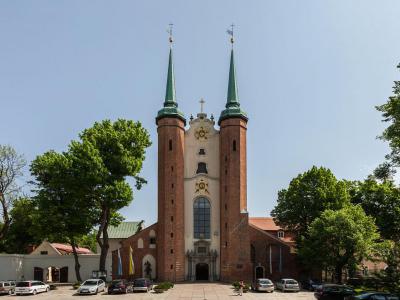Oliwa Cathedral, Gdansk
Oliwa Cathedral, formally known as the Archcathedral Basilica of the Holy Trinity, is a prominent church in Gdańsk. This magnificent edifice stands out as a three-nave basilica featuring a transept and a multisided closed presbytery, complete with an ambulatory. The cathedral's striking façade is adorned with two slender 46-meter-tall towers with sharply-edged helmets, a Baroque portal from 1688, varied-sized windows, and three cartouches. A notable feature of the cathedral is its bell tower, a characteristic element of Cistercian architecture.
Remarkably, the cathedral is 17.7 meters high, 19 meters wide, and 107 meters long, with the interior spanning 97.6 meters, making it the longest Cistercian church in the world. The cathedral's interior is a treasure trove of art from the Renaissance, Baroque, Rococo, and Classical periods, reflecting immense artistic value.
There are 23 altars within the cathedral, each of historical significance and mainly crafted in the Baroque and Rococo styles, with some made of marble. Their iconography reflects the principles of the post-Trent church. The most significant altar is the High Altar from 1688, celebrated as the finest Baroque artwork in Pomerania. Additionally, there is a noteworthy Netherland Renaissance style altar which served as the main altar until 1688. The cathedral's paintings, created by renowned 17th-century artists add to its grandeur.
The interior also houses Rococo chapels dedicated to the Holy Cross and Saint John of Nepomuk, an ambo, tombstones, epitaphs, and the tombs of the Pomeranian Dukes and the Kos family. Additionally, it contains a bishop's crypt, antique chandeliers, canopies, and numerous other antiquities. Of particular note is a feretory depicting Our Lady of Oliwa with the Infant Jesus, a revered object carried during the annual pilgrimage to the Calvary of Wejherowo.
Remarkably, the cathedral is 17.7 meters high, 19 meters wide, and 107 meters long, with the interior spanning 97.6 meters, making it the longest Cistercian church in the world. The cathedral's interior is a treasure trove of art from the Renaissance, Baroque, Rococo, and Classical periods, reflecting immense artistic value.
There are 23 altars within the cathedral, each of historical significance and mainly crafted in the Baroque and Rococo styles, with some made of marble. Their iconography reflects the principles of the post-Trent church. The most significant altar is the High Altar from 1688, celebrated as the finest Baroque artwork in Pomerania. Additionally, there is a noteworthy Netherland Renaissance style altar which served as the main altar until 1688. The cathedral's paintings, created by renowned 17th-century artists add to its grandeur.
The interior also houses Rococo chapels dedicated to the Holy Cross and Saint John of Nepomuk, an ambo, tombstones, epitaphs, and the tombs of the Pomeranian Dukes and the Kos family. Additionally, it contains a bishop's crypt, antique chandeliers, canopies, and numerous other antiquities. Of particular note is a feretory depicting Our Lady of Oliwa with the Infant Jesus, a revered object carried during the annual pilgrimage to the Calvary of Wejherowo.
Want to visit this sight? Check out these Self-Guided Walking Tours in Gdansk. Alternatively, you can download the mobile app "GPSmyCity: Walks in 1K+ Cities" from Apple App Store or Google Play Store. The app turns your mobile device to a personal tour guide and it works offline, so no data plan is needed when traveling abroad.
Oliwa Cathedral on Map
Sight Name: Oliwa Cathedral
Sight Location: Gdansk, Poland (See walking tours in Gdansk)
Sight Type: Religious
Sight Location: Gdansk, Poland (See walking tours in Gdansk)
Sight Type: Religious
Walking Tours in Gdansk, Poland
Create Your Own Walk in Gdansk
Creating your own self-guided walk in Gdansk is easy and fun. Choose the city attractions that you want to see and a walk route map will be created just for you. You can even set your hotel as the start point of the walk.
Gdansk's Historical Churches Tour
Gdansk has a long history of Catholicism, hence the abundance of spectacular churches here. Let's delve into some of the most impressive temples that grace the cityscape and see what they are.
Saint John's Church, a Gothic masterpiece, stands tall in the heart of Gdansk. It dates back to the 14th century and features impressive brickwork and intricate details. Its towering spire is a... view more
Tour Duration: 1 Hour(s)
Travel Distance: 1.6 Km or 1 Miles
Saint John's Church, a Gothic masterpiece, stands tall in the heart of Gdansk. It dates back to the 14th century and features impressive brickwork and intricate details. Its towering spire is a... view more
Tour Duration: 1 Hour(s)
Travel Distance: 1.6 Km or 1 Miles
Gdansk Introduction Walking Tour
The most probable source for the name, "Gdansk" seems to be "Gdania", the ancient name of the river Motlawa. Gdansk began with agriculture and fishing and trade with Pomerania in the 9th century. It was annexed by Mieszko, Duke of Poland, in 975.
The center of town was the Long Market, with its craftsmen. German merchant settlements grew by St Nicholas Church. Gdansk joined... view more
Tour Duration: 2 Hour(s)
Travel Distance: 2.2 Km or 1.4 Miles
The center of town was the Long Market, with its craftsmen. German merchant settlements grew by St Nicholas Church. Gdansk joined... view more
Tour Duration: 2 Hour(s)
Travel Distance: 2.2 Km or 1.4 Miles
Solidarity Union Walking Tour
For decades, the word 'Solidarity' (Polish: Solidarność) has been synonymous with the city of Gdansk. The peaceful Solidarity revolution, started here in the August of 1980, marked the outset of the fall of communism not only in Poland but also throughout Eastern Europe.
Stemmed from the country's first free labor union born out of strikes at the Lenin Shipyard (now the Gdansk... view more
Tour Duration: 1 Hour(s)
Travel Distance: 0.8 Km or 0.5 Miles
Stemmed from the country's first free labor union born out of strikes at the Lenin Shipyard (now the Gdansk... view more
Tour Duration: 1 Hour(s)
Travel Distance: 0.8 Km or 0.5 Miles






